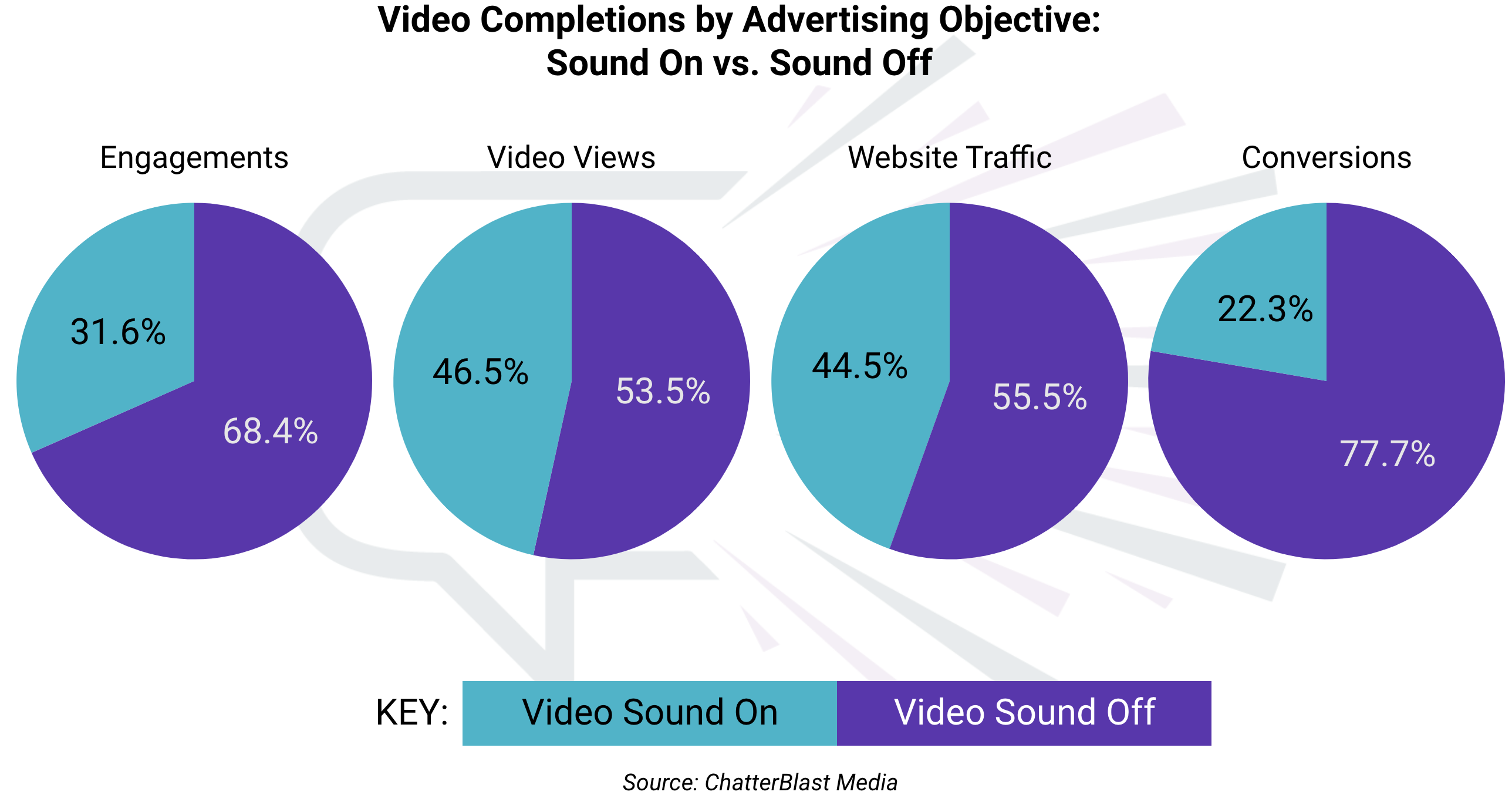As we have all witnessed in the past 22 months, Covid-19 has affected every single thing in our lives. The world of advertising, social media, and digital marketing has been forced to take a huge turn and make changes we never saw coming. More than 75% of consumers engage with more digital content now compared to life before the pandemic.
Across 2021, the ChatterBlast ads & analytics team started to notice trends pertaining to the use of sound in video for advertising, as well as the auto-play feature. We wanted to understand what works — and for which ad objectives — so we embarked on some extensive research and analysis on Facebook. With the data we collected, we can draw conclusions that inform better video advertising content moving forward.
Why video?
Video advertising is something that has been around for years, but really took off when Covid hit. The presence and use of social media increased significantly, so brands turned to those sites to advertise. According to Forbes, “viewers retain 95% of a message when they watch it on video, compared to 10% when reading it in a text.” Other studies have shown that videos get roughly 12 times more shares than text and images combined. By using video, brands can focus on customer personalization as well as data collection, which can help improve their product and develop their audience.
Trend: sound vs. no sound
Preference in sound varies by ad objective — when targeting for people to watch more of a video or driving them to a website, they are slightly more inclined to turn the sound on, but if you want them to make a conversion action or react, share, or comment on a post, they likely don’t turn up the volume. The simple majority (53–78 percent) of people prefer sound off, but this data is a far cry from where things were five years ago.
To dive deeper into the data we collected, we looked at different ad objectives through the lens of 100% video completions, i.e. where people watched a whole video — regardless of length — from start to finish. Our ad objectives consisted of traffic (ads that drive people to websites), engagement (ads that drive people to like, share, comment or click), video views (ads targeted to people that will likely watch at least 3–15 seconds of a video), and conversions (ads that drive people to take a specific action on a website). This approach allows us to see which type of video is best for each objective, and how we can tailor creative to suit trending behavior.
If we’re looking at engagement videos playing at 100%, most people preferred sound off (31.59% with sound on vs. 68.41% with sound off) and nearly everyone utilizes auto-play (99.87% used auto-play and 0.13% used click-to-play). These numbers tell us that while people often have full control over whether or not audio plays in their ads, they’re much less likely to opt-in to forcing ads to play, especially under certain circumstances.
Trend: auto-play vs. click-to-play
Our data dictates that all the objectives within video have much higher percentages for auto-play. All the objectives we explored for 100% video completions have auto-play accounting for 85% of those completions, except for website traffic, which falls between 79% and 85%. Another observation is that the length of the video has less of an impact for auto-play, in comparison to sound.
There are pros and cons to auto-play vs. click-to-play, which allows the viewer to actively decide if they want to watch the advertisement or not. While companies lose the option to see how many people would skip forward or pass on their ad with auto-play enabled, video strategy shifts to catching a viewer’s attention within the first few seconds. Since most people don’t opt for click-to-play, knowing how Facebook serves these ads can also help tremendously with building content to best suit your audience.
Trend: using captions
Another key aspect of video advertising is the use of captions. Interestingly, we saw that consumers prefer no sound when captions are available and no sound when the video will auto-play. Outside research has shown that “80% of consumers are more likely to watch video all the way through when captions are available.” This could be for reasons such as not wanting to play a video out loud while in public or for other privacy reasons. Captions allow for the message to be displayed without forcing the viewer to listen, and they are also a great tool for making your content more accessible.
If a brand has a jingle or song associated with their ad, using that specific sound at the beginning of the video allows them to be recognized by viewers. A way to implement this with sound off would be the use of captions like *JINGLE*, or *THEME SONG*, which might catch the interest of a viewer. Our big takeaway from our research is that if a video is going to auto play, having captions available is crucial for people to watch it.
The final variable to consider is the length of the video ad. According to Marketing Sherpa, most people prefer shorter ads, especially if there’s a sequence of ads back to back. Since video ads have high engagement rates, the duration of the ad is important for brands to consider. Across the ads we researched, we found that engagement and video view ads are best for longer videos (averaging 10 to 12 seconds of view time), followed by website traffic ads (averaging 8 seconds), and finally, conversion ads (averaging 6.5 seconds). If you only want people to consume your video, make it longer. If you want them to take an action or go to your website, keep it short and quickly establish your brand.
Although all of the data we collected was through Facebook, brands can apply these learnings to other platforms. By breaking down creative performance into separate categories like click-to-play and the use of sound, then even further by objective, we saw specific figures that led to a deeper understanding.
By using a mix of data, customer preferences, and trends, your brand can create video advertisements that effectively get the message across while keeping views engaged. If you’re curious how to put this research into action, reach out to us!






